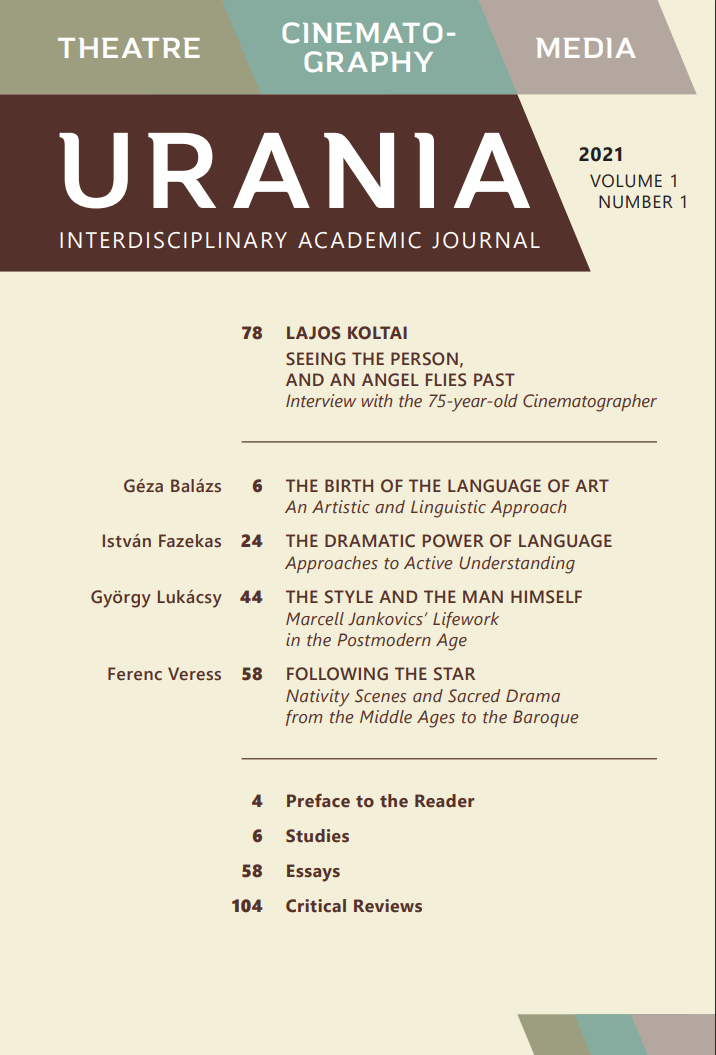Following the Star
Nativity Scenes and Sacred Drama from the Middle Ages to the Baroque
Abstract
The study aims to show the origin and function of nativity scenes, a popular accessory of the Christmas holiday circle, in the liturgy. In the early Christian period, there was great interest in the scenes of Jesus' life, and therefore many pilgrims visited the Holy Land. Already in the letters of St. Jerome we find descriptions of the emotions evoked by the visit to Bethlehem. In the Basilica of Santa Maria Maggiore, fragments of the nativity manger were preserved, so one of the earliest nativity scenes, Arnolfo di Cambio's sculpture group (late 13th century), can be found here. Arnolfo's work was done by the same IV. It was commissioned by Pope Nicholas, who also supported the decoration of the Franciscan basilica in Assisi. A scene from Giotto's fresco cycle in Assisi depicts the miracle of St. Francis in Greccio, that is, the Holy Mass celebrated over the manger and the coming to life of the infant placed in the manger. In the period of the Renaissance and Baroque, there are many examples of nativity scenes, both from the genres of painting and sculpture. In the liturgy, the genre of sacred drama emerged from the sacrificial procession of the faithful, which, leaving the church square, expanded into a mystery play. The nativity scenes, which show the influence of mystery plays, primarily wanted to make the miracle of the Incarnation tangible for believers.
References
Baranyai Béláné. 1975. „Mesterek és műhelyek az északkelet-magyarországi barokk szobrászatban.” In Magyarországi reneszánsz és barokk, Művészettörténeti tanulmányok, edited by Galavics Géza, 313–450. Budapest: Akadémiai Kiadó.
Baxandall, Michael. 1986. Reneszánsz szemlélet – reneszánsz festészet. Translated by Falvay Mihály. Budapest: Corvina Kiadó.
Bálint Sándor. 1989. Karácsony, Húsvét, Pünkösd. A nagyünnepek hazai és közép-európai hagyományvilágából. 3rd edition. Budapest: Szent István Társulat.
Berliner, Rudolf. 1946. ‘The Origins of the Crèche.’ Gazette des Béaux-Arts 30: 249– 278. https://doi.org/10.2307/3047476 https://doi.org/10.1080/00043079.1953.11408173
Berliner, Rudolf. 1953. ‘A Relief of the Nativity and a Group from an Adoration of the Magi.’ The Art Bulletin 35/2: 145–150.
Braun, Joseph. 1924. Der Christliche Altar in seiner geschichtliche Entwicklung. vol. I–II. Munich: Alte Meister Guenther Koch & Co.
Chastel, André and Angela Ottino Della Chiesa. 1997. Caravaggio festői életműve. Edited by Raffaella Morsetti, translated by Aczél Ferenc. Budapest: Corvina Kiadó.
Dávid Ferenc. 1983. „Sopronbánfalva-kolostorhegyi lépcső. Adatok Schweitzer György soproni szobrász működéséhez.” Építés-építészettudomány 15: 55–92.
Dercsényi Dezső. 1950. „Adalékok a pécsi domborművek ikonográfiájához.” Archaeológiai Értesítő 77: 90–96.
E. Abaffy Erzsébet. 1997. Debreceni kódex 1519. A nyelvemlék hasonmása és betűhű átirata. Introductory study by Madas Edit and Reményi Andrea. [Régi Magyar Kódexek 21]. Budapest: Argumentum Kiadó – Magyar Nyelvtudományi Társaság.
Falkenburg, Reindert. 2007. ‘Hieronymus Bosch’s Mass of Saint Gregory and “sacramental vision”.’ In Das Bild der Erscheinung. Die Gregorsmesse im Mittalalter, edited by Andreas Germans and Thomas Lentes, 178–206. Berlin: Dietrich Reimer Verlag.
Forsyth, William H. 1989. ‘Popular Imagery in a Fifteenth-Century Burgundian Crèche.’ The Metropolitan Museum Journal 24: 117–126. https://doi.org/10.2307/1512873
Földváry Miklós István. 2017. Egy úzus születése. A Chartvirgus-pontifikálé és a magyarországi liturgia megalkotása a XI. században. Budapest: Argumentum – ELTE-BTK Vallástudományi Központ Liturgiatörténeti Kutatócsoport.
Friedlaender, Walter. 1955. Caravaggio studies. Princeton: Princeton University Press.
Garas Klára. 1960. Franz Anton Maulbertsch (1724–1796). Budapest: Hungarian Academy of Sciences Publishing House.
Groiss, Eva. 1979. Die Bildhauerstadt Weilheim. In Die Bildhauerfamilie Zürn. 1585– 1724, edited by Benno Ulm, 85–94. Braunau am Inn: Land Oberösterreich.
Guinommet, Claire. 2017. Das italienische Sakramentstabernakel im 16. Jahrhundert. München: Hirmer.
Hatfield, Rab. 1970. ‘The Compagnia de’ Magi.’ Journal of the Warburg and Courtauld Institutes 33: 107–161. https://doi.org/10.2307/750893
Házi Jenő. 1939. Sopron középkori egyháztörténete. Sopron: Székely és Társa Kiadó.
Hidász Ferenc and Várnai Jakab, eds. 1996. Celanói Tamás életrajzai Szent Ferencről. Translated by Balanyi György. [Ferences források 2]. Újvidék – Szeged – Csíksomlyó: Agapé Kiadó.
Jernyei Kiss János. 2019. Barokk freskófestészet Magyarországon I. Fejér, Esztergom és Veszprém megye. Budapest: MMA Kiadó.
Kapossy János. 1930. Maulbertsch sümegi freskóműve. Archaeológiai Értesítő 44: 179–193.
Karsai Géza. 1938. Középkori vízkereszti játékok. A győri »Tractus stellae« és rokonai. Budapest: Szent István Társulat.
Krautheimer, Richard. 1963. Early Christian and Byzantine Architecture. Harmondsworth, Middlesex: The Penguin Books.
Ostrow, Steven F. 1996. Art and Spirituality in Counter-Reformation Rome: the Sistine and Pauline Chapels in S. Maria Maggiore. Cambridge – New York: Cambridge University Press.
Panofsky, Erwin. 1971. Early Netherlandish Painting. Its Origins and Character. I–II. New York: Icon Editions, Harper & Row.
Pécsváradi Gábor. 1983. Jeruzsálemi utazás. Translation, introductory study and notes by Holl Béla. [Magyar ritkaságok]. Budapest: Szépirodalmi Könyvkiadó.
Pomarici, Francesca. 1988. ‘Il Presepe di Arnolfo di Cambio: nuova proposta di ricostruzione.’ Arte Medievale 2: 155–174.
Ridderbos, Bernhard. 1990. ‘Die Geburt Christi des Hugo van der Goes. Form, Inhalt, Funktion.’ Jahrbuch der Berliner Museen 32: 137–152. https://doi.org/10.2307/4125824
Saint Jerome. 2005. Levelek. I-II. Translated by Puskely Mária and Takács László. Budapest: Szenzár Kiadó.
Szauder József. 1977. Kövek és könyvek. Esszék Itáliáról. Budapest: Szépirodalmi Könyvkiadó.
Teres Ágoston. 2005. Biblia és asztronómia. Mágusok és a csillag Máté evangéliumában. 4th edition. Kecskemét: Korda Kiadó.
Tóth Melinda. 1994. „A pécsi székesegyház kőszobrászati díszítése a románkorban.” In Pannonia Regia. Művészet a Dunántúlon 1000–1541, edited by Takács Imre and Mikó Árpád, 123–154. Budapest: Hungarian National Gallery.
Türks, Paul. 2004. Néri Szent Fülöp, az öröm prófétája. Translated by Lerch Gabriella. Budapest: Kairosz Kiadó.
Végh János. 2000. „Gótikus szobrok barokk oltárokban.” In Történelem-kép. Szemelvények múlt és művészet kapcsolatából Magyarországon, edited by Mikó Árpád and Sinkó Katalin, 471–477. Budapest: Hungarian National Gallery.
Vigorelli, Giancarlo and Edi Baccheschi. 1984. Giotto festői életműve. Translated by Nádasdy Ádám. Budapest: Corvina Kiadó.
Williamson, Beth. 2013. ‘Sensory Experience in Medieval Devotion: Sound and Vision, Invisibility and Silence.’ Speculum 88/1: 1–43. https://doi.org/10.1017/S0038713413000523
Young, Karl. 1933. The Drama of the Medieval Church. I–II. Oxford: Clarendon Press.




